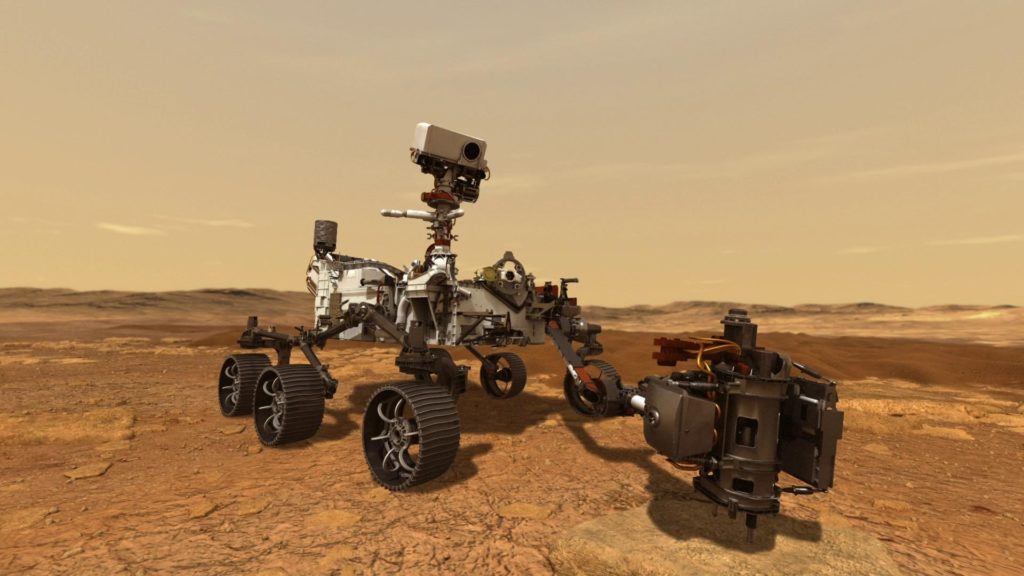Article: Amagmatic hydrothermal systems on Mars from radiogenic heat
Authors: L. Ojha, S. Karunatillake, S. Karimi, and J. Buffo
Many people are familiar with Yellowstone National Park’s famous geyser, Old Faithful – but did you know that the heat fueling Old Faithful’s eruptions are from magma chambers that warm up underground fluids until they shoot out of the ground? Hydrothermal systems like this are found in other places, too, and can be fueled by different kinds of heat sources. In fact, scientists at Rutgers University have recently identified one such heat source – the heat generated by radioactive decay from certain chemical elements – that could help answer questions about whether liquid water, a critical component for life as we know it, could exist on Mars.
There are many lifeforms on Earth that live near hydrothermal systems because the systems contain important conditions to support and sustain life: “redox gradients, energy sources, and aqueous solutions rich in elements essential for life” (Ojha et al., 2021). Life as we know it needs food, water, and energy to survive and hydrothermal systems provide these all in one place. There are many features on Mars that suggest it previously had abundant liquid surface and near-subsurface water: features from ancient lakes and rivers, minerals with water incorporated into them, and weathering signatures indicative of water. Even more importantly, some of these water features are consistent with hydrothermal systems that have been observed on Earth. How long it took to form these features and whether this demonstrates that Mars could sustain life is a big question in determining Mars habitability potential as it takes a long time for life to develop and take hold. If hydrothermal systems heated by radioactive decay existed on Mars, they would have lasted longer than those heated by magma because radioactive elements release heat due to radioactive decay, which can happen slowly over billions of years. Liquid water is a critical component for life as we know it, and to sustain conditions for life to grow and develop, it must be liquid for a long time.

The authors of this study investigated the Eridania region of Mars and its surroundings for enrichment of thorium (Th), potassium (K), and uranium (U) and studied how the decay of such heat-producing elements (HPEs) affects the heat flow in the crust (heat flow of a planetary body is the movement of heat from the subsurface (like the core, mantle, or near-subsurface) to the surface). The heat generated from a magmatic body into a hydrothermal system is generally less intense and doesn’t last as long as it does from a radiogenic hydrothermal system. The authors used the Gamma Ray Spectrometer Suite on the Mars Odyssey Orbiter to map areas of enrichment of the targeted elements in the mid- to low-latitudes of the Martian surface to then determine heat flow. These elements were observed to be enriched in this area, not only indicating potential heat flow from radiogenic decay, but also because they are associated with a submarine-like setting, which puts the two pieces of the puzzle together: a hydrothermal system that could be linked to radioactive decay processes.
You may ask – does this mean that the hydrothermal systems couldn’t have been fed by magmatic activity? We don’t know for sure yet, but to find out the authors turn to the crustal properties of the region and how craters (especially large crater basins) form in the region. Although both magmatic- and amagmatic-fed hydrothermal systems will heat the crust, magmatic systems change the temperature of the crust at depth while amagmatic systems do not. This change leads to the magmatic systems creating a crust that creates large crater basins that undergo viscoelastic relaxation, or exhibiting characteristics of both viscous (flowy) and elastic (bounce-back) relaxation after impact. This region happens to have a crust that is more consistent with an amagmatic system, so putting all of these pieces of evidence together, makes for compelling evidence that the hydrothermal systems in this study region could’ve been heated by radioactive decay of certain elements.
Although Yellowstone’s hydrothermal geysers are heated by magma, some of Mars’ hydrothermal areas may have been heated by radioactive decay. Elemental enrichment and crustal properties of the Eridania region of Mars point to maybe having previously had an amagmatic hydrothermal system. If true, this could have sustained warm liquid water on Mars for longer than magma-fed hydrothermal systems, which has important implications for the study of life on Mars. Water heated for longer could give life the chance to develop and evolve over a longer period of time, and potentially a higher chance that the Perseverance Rover may find life in the rocks that it is studying.
Life on Mars: a non-traditional source for warmer waters by Lori Pigue is licensed under an Attribution-Non-Commercial ShareAlike 4.0

